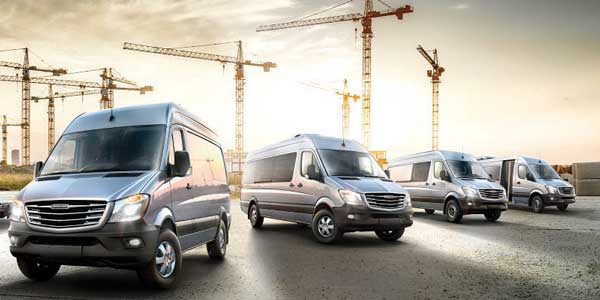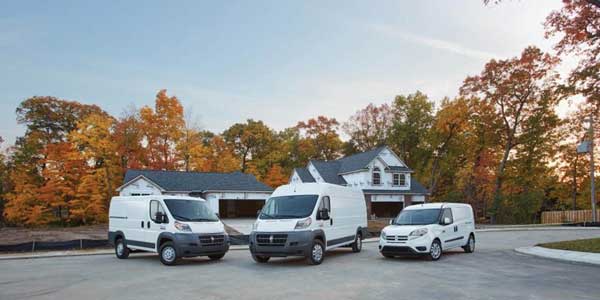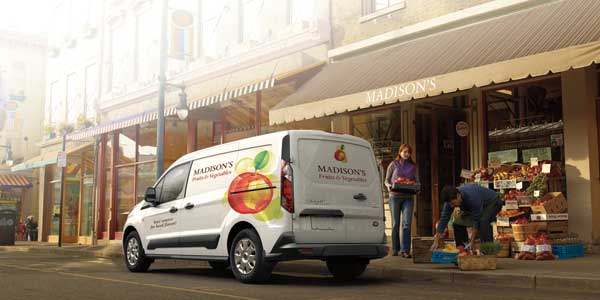
European styling, American demands: The evolution of modern vans
Van bodies seem to be evolving these days, and some designs have a global look to them. Let’s take a look at the emerging European-style trends in the van market.
European styling
It has been several years since the Mercedes-Benz Sprinter van first became available in the U.S., while the company’s Metris van is a fairly new product in this country. “The Sprinter was the original Euro-style van in the U.S. market, launched already more than 15 years ago,” says Mathias Geisen, general manager of product management and marketing for Mercedes-Benz USA Vans. “Today, Euro-style vans dominate the U.S. market. The Sprinter is now available as both the Mercedes-Benz Sprinter and the Freightliner Sprinter, and we have seen consistent sales growth year-over-year. The Sprinter offers fuel-efficient diesel engines, best-in-class service intervals, comfortable handling and a high safety level. Additionally, the upfitter program, called MasterSolutions, provides extensive off-the-shelf upfit.
“The Mercedes-Benz Metris is a mid-size van but has a payload capacity of more than 2,500 lbs. and the ability to fit in nearly any parking space or garage,” Geisen says. “The Metris provides flexibility that both small business owners and fleet operators require.”
RELATED: Watch our video look at the Metris van here.
The Sprinter Worker models can be purchased in configurations that include four distinct models, three GVWRs, three body lengths, three roof heights, two wheelbases, two diesel engines and two drivetrains, and the Crosswind Assist safety system. The Sprinter offers two turbocharged diesel engine choices—a 2.1-liter inline-4 engine paired with the 7G-TRONIC transmission and a 3.0-liter V6 paired with a 5-speed transmission.
Ram offers the Euro-style ProMaster line of vans, which were derived from the European van provided by Fiat Professional, the Ducato and the Doblo.
“The European van design is strategic in that the vans are engineered to be versatile and economical since vans do the work of pickup trucks in Europe,” says Dave Sowers, head of Ram commercial marketing. “The ProMaster lineup utilizes a uni-body construction with front-wheel drive, which not only provides excellent traction and maneuverability, but also allows the vans to be lighter and more efficient. In the NAFTA market, the large van segment for years was dominated by heavy body-on-frame vans with less efficient V8 powertrains, but the market is changing and the European vans are more prevalent.”
“Ram’s large van, ProMaster, utilizes front-wheel drive, which is a class exclusive in the large van segment,” Sowers contines. “This allows the ProMaster to be lighter and more efficient while providing very impressive payload capability. This efficient design gives it the lowest load floor in the segment, and when combined with the standard roof height, provides the tallest interior cargo height. It also utilizes front-wheel drive and is equipped with the most efficient powertrain in the segment; a 2.4L I-4 mated to a nine-speed automatic transmission.
“This powertrain delivers a highway fuel economy rating of 28 MPG,” he adds. “A Bi-Link rear suspension is standard on ProMaster City, which provides a better ride that traditional torsion beam. Dual-side sliding doors are also standard on the ProMaster City, while the larger ProMaster van has dual-side sliding doors as an option.”
ProMaster is available in 15 different configurations consisting of four body types—cargo van, window van, chassis cab, and cutaway—two roof heights, three wheelbases and four overall lengths.
“This makes ProMaster an excellent choice for the commercial customers with exceptional versatility and easy upfit capabilities,” Sowers notes. “The ProMaster City offers and abundance of versatility in the simplest form with two body types—cargo van and passenger van—one roof height, one wheelbase and one overall length.”
Added versatility
The evolution of vans goes beyond how the vans look to how they are used, says Julie Ellenberger, Ford’s brand manager for the Transit, Transit Connect and E-Series vans. “Moving from a traditional American van like the Ford E-Series to a modern global van design like the Ford Transit provides additional versatility that lets fleets do things with their vans that simply were not possible before,” she says. “Ford Transit is available in 64 configurations with three roof heights, three body lengths and two wheelbases to choose from. As a result, customers can specify a vehicle that has been right-sized specifically to meet individual business needs. They can work with our network of ship-through upfitters, 12 of which are located within 30 miles of the plant, to further customize the vans.
“For customers who need a smaller van, Ford invented the compact cargo van market in North America with Transit Connect,” she adds. “The long wheelbase Transit Connect cargo van offers up to 149 cu. ft. of storage and a maximum payload of 1,610 lbs. The short wheelbase van offers maneuverability and a maximum cargo space of 124.3 cu. ft. paired with a maximum payload rating of 1,470 lbs. Transit is available with a choice of three engines, three roof heights, three body lengths and two wheelbases: for a total of 64 configurations from the factory. Experts at our Commercial Vehicle Center dealers can help customers choose the perfect combination for their specific needs.”
American demands
“The evolved van bodies, while new to the U.S., are inspired by their European counterparts,” says Joseph Langhauser, commercial product sales support manager of vans and mobility for General Motors. “In Europe, the van market is very large; they’re used for similar roles as we’d use the full-size pickup in the U.S. Taking it from there, we’ve designed the Chevrolet Express and the GMC Savana to have the durability that American customers demand. We are committed to the current body on frame design and its durability, versatility and capability. These features have been a proven success and are requested by our customers. Bodies on frame vehicles are incredibly tough, and they allow for different body types to be mounted. Additionally, body on frame vehicles are easier to repair, reducing the downtime of our vehicles—meaning our customers can get back to business as usual as quickly as possible. Lastly, body on frame vehicles can tow more. The Chevrolet Express and GMC Savana can tow up to 10,000 lbs.”
“We have a broad range of products, and we work closely with professional upfitting partners who can match bodies and equipment with your specific vocational needs,” Langhauser adds. “GM Fleet account executives are available to help our customers and potential customers determine what vehicles and propulsion systems best meet their company’s needs.”
Van bodies
Hino’s cab-over-engines (COEs) cover 14,500-19,500 lb. GVW, and the company offers the Hino 210HP with 440 lb./ft. of torque. Hino Class 6 268 model maxes out at 26,000 lb. GVW and two Hino engine performance options—230 HP with 520 lb./ft. torque and 260 HP with 520 lb./ft. torque.
When asks what drives the evolution of van bodies these days, Paul Jarossy, director of business development for Morgan Corp., says, “Morgan has recognized this trend, which is why we have been out front and launched the NexGen body earlier this year. Lower weight, more corrosion-resistance, easy assembly, and a clean external look free from most fasteners have driven this. The features and benefits of new truck van designs includes 17-20% less weight, improving cargo capacity and/or less fuel requirements, aluminum cross-members and galvanized long-rails providing corrosion resistance, and fewer fasteners, which decrease the possibility of water intrusion.”



 Print
Print
 Email
Email




